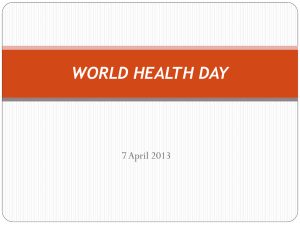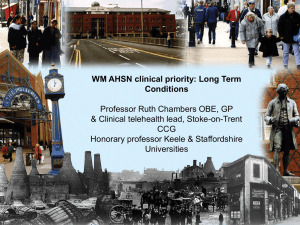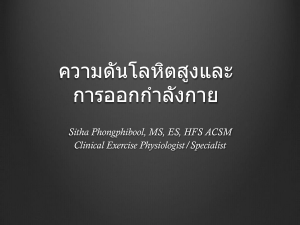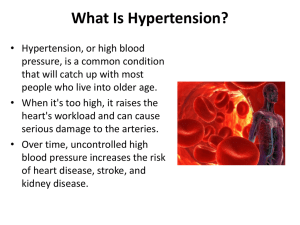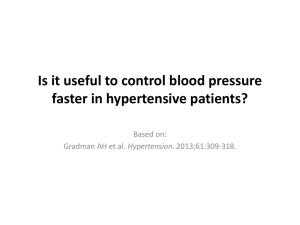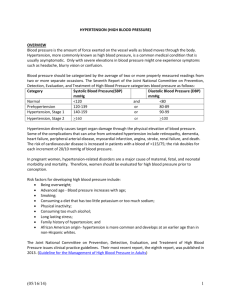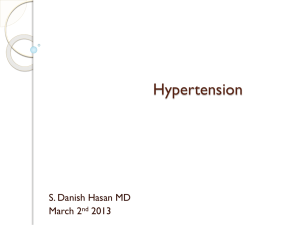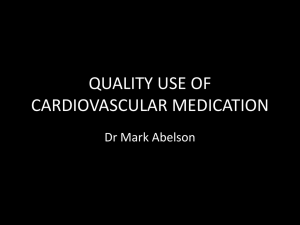HYPERTENSION
advertisement
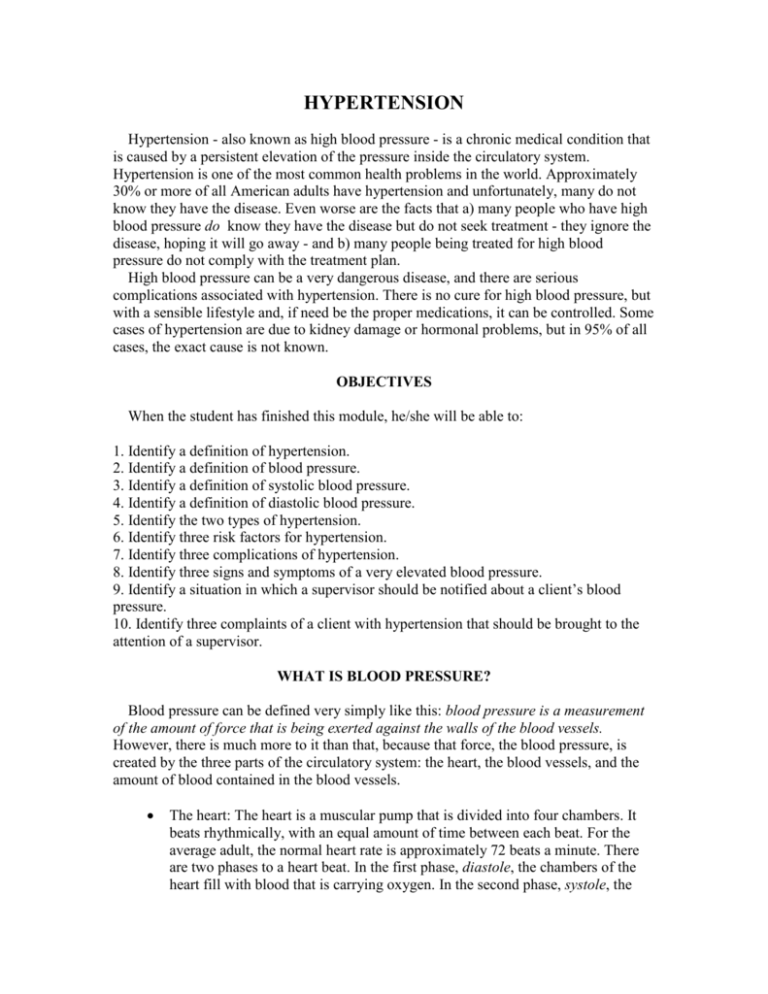
HYPERTENSION Hypertension - also known as high blood pressure - is a chronic medical condition that is caused by a persistent elevation of the pressure inside the circulatory system. Hypertension is one of the most common health problems in the world. Approximately 30% or more of all American adults have hypertension and unfortunately, many do not know they have the disease. Even worse are the facts that a) many people who have high blood pressure do know they have the disease but do not seek treatment - they ignore the disease, hoping it will go away - and b) many people being treated for high blood pressure do not comply with the treatment plan. High blood pressure can be a very dangerous disease, and there are serious complications associated with hypertension. There is no cure for high blood pressure, but with a sensible lifestyle and, if need be the proper medications, it can be controlled. Some cases of hypertension are due to kidney damage or hormonal problems, but in 95% of all cases, the exact cause is not known. OBJECTIVES When the student has finished this module, he/she will be able to: 1. Identify a definition of hypertension. 2. Identify a definition of blood pressure. 3. Identify a definition of systolic blood pressure. 4. Identify a definition of diastolic blood pressure. 5. Identify the two types of hypertension. 6. Identify three risk factors for hypertension. 7. Identify three complications of hypertension. 8. Identify three signs and symptoms of a very elevated blood pressure. 9. Identify a situation in which a supervisor should be notified about a client’s blood pressure. 10. Identify three complaints of a client with hypertension that should be brought to the attention of a supervisor. WHAT IS BLOOD PRESSURE? Blood pressure can be defined very simply like this: blood pressure is a measurement of the amount of force that is being exerted against the walls of the blood vessels. However, there is much more to it than that, because that force, the blood pressure, is created by the three parts of the circulatory system: the heart, the blood vessels, and the amount of blood contained in the blood vessels. The heart: The heart is a muscular pump that is divided into four chambers. It beats rhythmically, with an equal amount of time between each beat. For the average adult, the normal heart rate is approximately 72 beats a minute. There are two phases to a heart beat. In the first phase, diastole, the chambers of the heart fill with blood that is carrying oxygen. In the second phase, systole, the chambers forcefully contract and send a volume of blood out to the body through the blood vessels. The blood vessels: When we inhale, we take in oxygen through our lungs. The oxygen passes through the lung tissue and is delivered to thousands of tiny blood vessels. These deliver the blood with oxygen to the heart and it is then pumped out to the body through other blood vessels, the arteries and the capillaries. After the oxygen has been released to the parts of the body where it is needed, the veins carry the waste products of metabolism – mostly carbon dioxide – back from the body to the lungs. The carbon dioxide is removed when we exhale. The lungs deliver oxygen to the blood, that blood is delivered to the heart that has just released carbon dioxide and the cycle starts again. It is important to know that the arteries, capillaries, and veins are strong and have muscular tone. When the heart pumps a wave of blood out to the circulation, the blood vessels expand to accommodate the increased volume, but they also contract down in response, and that moves the blood along and out through the body. The blood: The blood volume for an average adult is approximately five liters, or about 5.2 quarts (It’s a little more for men, a little less for women). As explained above, blood carries oxygen to the body and carbon dioxide from the body to the lungs. If you think of the circulatory system – the heart, the blood vessels, and the blood – as a closed system, a closed loop, it is easy to see how all three of these components are needed for the blood pressure. Without a strong, functioning heart, there would be no initial movement of the blood out through the circulation. Without healthy, functioning arteries, etc., that wave of pressure could not continue and the blood would never reach the more distant parts of the body or return back to the heart. And without a normal blood volume, the closed system would obviously be empty and there would be no pressure at all. In the beginning of this section, blood pressure was defined as the measurement of the amount of force that is being exerted against the walls of the blood vessels. You can see however that this force/pressure varies. It rises when the heart pushes out a volume of blood (imagine squeezing on a tube of toothpaste with the cap closed; the pressure inside the tube will go up) and then it goes back down to a steady state that represents the pressure inside the blood vessels between each heartbeat. Learning Break: Remember: Blood pressure is defined as the measurement of the force exerted against the walls of the blood vessels. But the blood pressure is actually more complex than that. As mentioned above, blood pressure rises sharply during each heartbeat and there is also a steady state of pressure in the blood vessels between each heartbeat. The first of those two pressures – the pressure in the blood vessels as the heart is contracting – is called the systolic pressure and the second – the steady state pressure in the blood vessels between heart beats – is called the diastolic pressure. When you measure someone’s blood pressure you are checking the systolic and diastolic pressures. Learning Break: This was mentioned above, but it is worth repeating. The systolic blood pressure is the pressure in the blood vessels as the heart is actually contracting. The diastolic blood pressure is the steady state of pressure in the blood vessels between heart beats that the circulatory system is experiencing all the time. WHAT IS HYPERTENSION? Blood pressure is measured using a system of units called millimeters of mercury, and this is abbreviated as mm Hg. Normal blood pressure is defined as a systolic pressure less than 120 mm Hg, and a diastolic pressure less than 80 mm Hg. Hypertension is defined as a chronic condition in which the blood pressure is higher than 140 mm Hg or 90 mm Hg. It is important to remember that hypertension is a chronic condition: one single elevated reading does not mean that someone has high blood pressure. The blood pressure has to be measured and recorded over a period of time before it can definitely be stated someone has hypertension. Usually a healthcare professional will measure a patient's blood pressure three times, a week apart, and after the patient has been resting for five minutes or so. If the blood pressure is elevated at all three visits, the diagnosis of hypertension is confirmed. Learning Break: It is not uncommon for someone’s blood pressure to be high when he/she is stressed, anxious, or in pain. One of the more common situations in which this can happen is during a visit to a doctor. This phenomenon is called white coat hypertension. Because of this, it should never be decided on the basis of one measurement during a single visit to a physician that someone has hypertension. WHAT CAUSES HYPERTENSION? As mentioned in the introduction, there is no known or identifiable cause for 95% of all cases of hypertension: this type of hypertension is called essential hypertension. There are certainly risk factors and lifestyle issues that can increase the chances someone will develop the disease (these will be discussed later), but it has never been determined why most people develop high blood pressure. The other type of hypertension is called secondary hypertension. In these cases, there is a definite, identifiable cause for the disease. For some people, kidney disease can cause hypertension. Another cause of hypertension is a disease called Cushing's disease. People with Cushing's disease produce too much of a hormone called cortisol that increases blood pressure. An overactive thyroid gland can also cause hypertension. There is also a condition called pre-eclampsia that can happen during pregnancy that cause high blood pressure. However, although no one knows why most people develop hypertension, there are lifestyle factors and some other issues such as age, race, gender, and certain medical conditions that have been proven to increase someone’s risk for developing the disease. These factors can also aggravate an existing case of hypertension and worsen it. Smoking Obesity High salt diet Excess alcohol consumption Sedentary lifestyle Increasing age: Two-thirds of all Americans over the age of sixty have hypertension. Female gender Use of birth control pills Diabetes Sleep apnea Post-menopausal women Stress Depression Ethnic background: African-Americans males are at a higher risk. Family history of hypertension It is difficult to say which of these are the most important, but certainly, the risk factors of age, obesity, and being an African-American male are probably tops on the list, with smoking, and a sedentary lifestyle close behind. SIGNS AND SYMPTOMS OF HYPERTENSION Hypertension has long been called “the silent killer.” Other diseases have earned this name as well, but it is a very accurate way to describe hypertension. Hypertension has been called the silent killer because: Most people with hypertension have a mild or moderate hypertension and they do not know because they do not have any signs or symptoms. Because most people with hypertension don’t know they have the disease, it does not get treated and they develop complications and organ damage. It is usually only when the blood pressure gets to a very dangerous level that someone will develop health problems that he/she can feel and notice. The signs and symptoms of a very elevated blood pressure include: Chest pain Rapid heart beat Dizziness Headache Blurred vision Difficulty breathing Blood in the urine Unfortunately, most people have mild and moderate hypertension and there are no obvious warning signs or signals. However, when someone is living with a blood pressure that is elevated month after month and year after year, that constant high force puts a very serious strain on the blood vessels and some of the organs of the body. The result is that slowly but surely, the blood vessels and the “target” organs become damaged. Combine that fact with the absence of signs and symptoms of mild to moderate hypertension and it is clear why hypertension has been called the silent killer. COMPLICATIONS OF HYPERTENSION There are numerous complications of hypertension, and most of them are very serious. Heart disease Stroke Kidney disease Blindness Heart failure These complications – except for stroke – are very similar to hypertension. They are often developing very slowly without any signs or symptoms. And when the person with hypertension begins to notice changes in the way he/she feels, these issues of heart disease or kidney damage, etc. are already very advanced and the damage has been done. PREVENTING AND TREATING HYPERTENSION There is no cure for hypertension. Also, hypertension will almost inevitably develop in a certain segment of the population. These facts can cause some people to decide that it is not worth the trouble, expense, and inconvenience of changing their lifestyle or trying to treat the disease. Yet although hypertension may not be curable and for some people it may be unavoidable, it can most definitely be, to some degree, prevented and treated. However, that can be a big challenge. In the healthcare community, hypertension has been known informally for years as the disease of halves: half of the people who have hypertension don’t know they have it, half of the people who know they have it don’t seek treatment, and half of the people who seek treatment only comply with their doctor’s advice half the time. Prevention of hypertension is not complicated. The first step is to have the blood pressure checked several times a year. For some people with risk factors such as a strong family history of hypertension or African-American males, blood pressure should be checked regularly starting at in the early 20s. People who are over the age of 60 should also have their blood pressure checked regularly The next step in preventing hypertension involves making lifestyle changes. Many people find these changes very difficult to accomplish. Hypertension has definitely been associated with obesity, smoking, a high-salt diet, and a sedentary lifestyle (among other things) and it has been very well documented that losing weight, stopping smoking, eating a “healthy” diet, and exercising regularly are quite hard for people to start and stick with. Treating hypertension involves making the lifestyle changes mentioned above and using a variety of oral medications. There are many different classes of medications that can be used to lower the blood pressure. Each one works by a different mechanism. All of them have side effects, and some of these side effects can be very disturbing, such as impotence in males, confusion, excessive urination, and depression. Learning Break: It has been proven that a low-salt diet, losing weight, stopping smoking, staying active, and other healthy lifestyle habits will lower an elevated blood pressure. Let your clients know this and also let them know these changes have other health benefits such as preventing diabetes and heart disease. Making these changes is also, in the long run, simpler, less expensive, and easier than taking medications – some of which have unpleasant side effects. Learning Break: You can also let your clients know that although it is difficult to stop smoking, lose weight, take medications, etc., the complications of untreated hypertension can be devastating. Hypertension is one of the leading causes of kidney disease, stroke, and blindness. CARING FOR THE PATIENT WITH HYPERTENSION Caring for someone with hypertension should start with recognizing the people who are at risk. Remember, people over the age of 60, African-Americans, people who are obese are very likely to have or develop hypertension. If you are caring for someone who has any of these risk factors, make sure you ask that person when he/she last had the blood pressure measured. The next step is to make sure that you accurately measure the client’s blood pressure properly. Use the proper size blood pressure cuff, do not place the cuff over a shirt, sweater, etc., make sure the arm is at the level of the heart, and make sure the client is lying or sitting and has been resting for at least two minutes. Compare the blood pressure you have measured to the previous readings. If it is drastically higher or lower, let your supervisor now immediately. You should also immediately notify your supervisor if the systolic pressure is greater than 140, the diastolic pressure is greater than 90, or if the client is complaining of chest pain, headache, dizziness, shortness of breath, or blurred vision.
